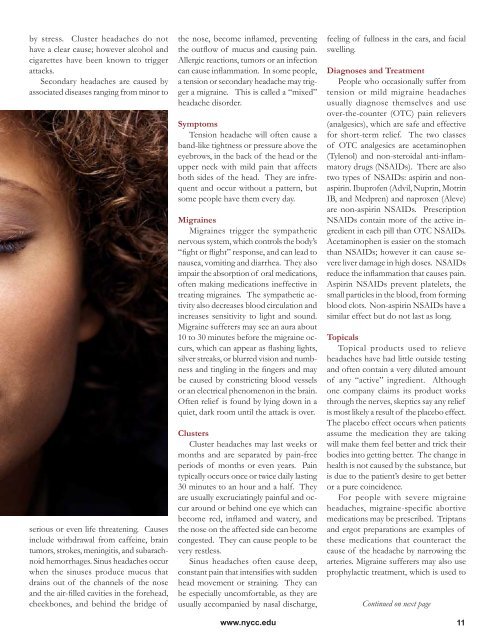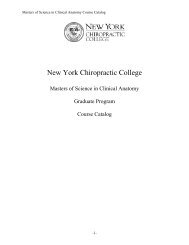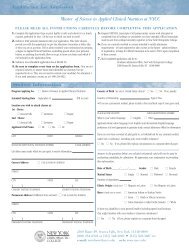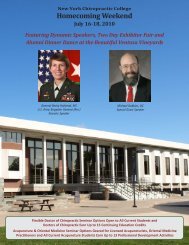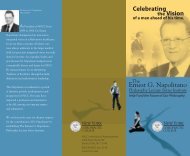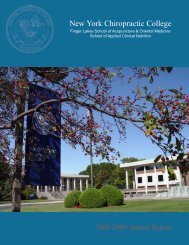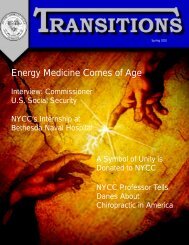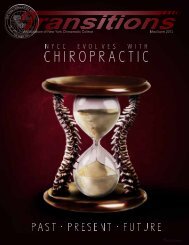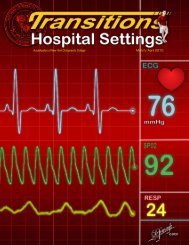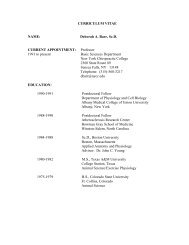May - June 2009 (PDF Version) - New York Chiropractic College
May - June 2009 (PDF Version) - New York Chiropractic College
May - June 2009 (PDF Version) - New York Chiropractic College
You also want an ePaper? Increase the reach of your titles
YUMPU automatically turns print PDFs into web optimized ePapers that Google loves.
y stress. Cluster headaches do not<br />
have a clear cause; however alcohol and<br />
cigarettes have been known to trigger<br />
attacks.<br />
Secondary headaches are caused by<br />
associated diseases ranging from minor to<br />
serious or even life threatening. Causes<br />
include withdrawal from caffeine, brain<br />
tumors, strokes, meningitis, and subarachnoid<br />
hemorrhages. Sinus headaches occur<br />
when the sinuses produce mucus that<br />
drains out of the channels of the nose<br />
and the air-filled cavities in the forehead,<br />
cheekbones, and behind the bridge of<br />
the nose, become inflamed, preventing<br />
the outflow of mucus and causing pain.<br />
Allergic reactions, tumors or an infection<br />
can cause inflammation. In some people,<br />
a tension or secondary headache may trigger<br />
a migraine. This is called a “mixed”<br />
headache disorder.<br />
Symptoms<br />
Tension headache will often cause a<br />
band-like tightness or pressure above the<br />
eyebrows, in the back of the head or the<br />
upper neck with mild pain that affects<br />
both sides of the head. They are infrequent<br />
and occur without a pattern, but<br />
some people have them every day.<br />
Migraines<br />
Migraines trigger the sympathetic<br />
nervous system, which controls the body’s<br />
“fight or flight” response, and can lead to<br />
nausea, vomiting and diarrhea. They also<br />
impair the absorption of oral medications,<br />
often making medications ineffective in<br />
treating migraines. The sympathetic activity<br />
also decreases blood circulation and<br />
increases sensitivity to light and sound.<br />
Migraine sufferers may see an aura about<br />
10 to 30 minutes before the migraine occurs,<br />
which can appear as flashing lights,<br />
silver streaks, or blurred vision and numbness<br />
and tingling in the fingers and may<br />
be caused by constricting blood vessels<br />
or an electrical phenomenon in the brain.<br />
Often relief is found by lying down in a<br />
quiet, dark room until the attack is over.<br />
Clusters<br />
Cluster headaches may last weeks or<br />
months and are separated by pain-free<br />
periods of months or even years. Pain<br />
typically occurs once or twice daily lasting<br />
30 minutes to an hour and a half. They<br />
are usually excruciatingly painful and occur<br />
around or behind one eye which can<br />
become red, inflamed and watery, and<br />
the nose on the affected side can become<br />
congested. They can cause people to be<br />
very restless.<br />
Sinus headaches often cause deep,<br />
constant pain that intensifies with sudden<br />
head movement or straining. They can<br />
be especially uncomfortable, as they are<br />
usually accompanied by nasal discharge,<br />
www.nycc.edu<br />
feeling of fullness in the ears, and facial<br />
swelling.<br />
Diagnoses and Treatment<br />
People who occasionally suffer from<br />
tension or mild migraine headaches<br />
usually diagnose themselves and use<br />
over-the-counter (OTC) pain relievers<br />
(analgesics), which are safe and effective<br />
for short-term relief. The two classes<br />
of OTC analgesics are acetaminophen<br />
(Tylenol) and non-steroidal anti-inflammatory<br />
drugs (NSAIDs). There are also<br />
two types of NSAIDs: aspirin and nonaspirin.<br />
Ibuprofen (Advil, Nuprin, Motrin<br />
IB, and Medpren) and naproxen (Aleve)<br />
are non-aspirin NSAIDs. Prescription<br />
NSAIDs contain more of the active ingredient<br />
in each pill than OTC NSAIDs.<br />
Acetaminophen is easier on the stomach<br />
than NSAIDs; however it can cause severe<br />
liver damage in high doses. NSAIDs<br />
reduce the inflammation that causes pain.<br />
Aspirin NSAIDs prevent platelets, the<br />
small particles in the blood, from forming<br />
blood clots. Non-aspirin NSAIDs have a<br />
similar effect but do not last as long.<br />
Topicals<br />
Topical products used to relieve<br />
headaches have had little outside testing<br />
and often contain a very diluted amount<br />
of any “active” ingredient. Although<br />
one company claims its product works<br />
through the nerves, skeptics say any relief<br />
is most likely a result of the placebo effect.<br />
The placebo effect occurs when patients<br />
assume the medication they are taking<br />
will make them feel better and trick their<br />
bodies into getting better. The change in<br />
health is not caused by the substance, but<br />
is due to the patient’s desire to get better<br />
or a pure coincidence.<br />
For people with severe migraine<br />
headaches, migraine-specific abortive<br />
medications may be prescribed. Triptans<br />
and ergot preparations are examples of<br />
these medications that counteract the<br />
cause of the headache by narrowing the<br />
arteries. Migraine sufferers may also use<br />
prophylactic treatment, which is used to<br />
Continued on next page<br />
11


